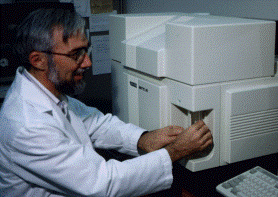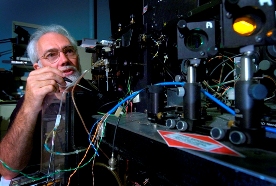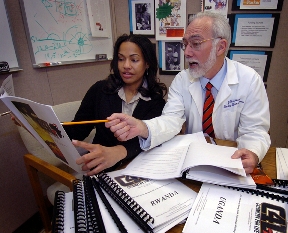Home Research Centers Purdue University Cytometry Laboratories

Purdue University Cytometry Laboratories
by J. Paul Robinson

Purdue University Cytometry Laboratories (PUCL) was founded in 1988 by Dr. J. Paul Robinson, and has been a focal center for the field of cytometry since. At the time of publication of this DVD set, Dr. J. Paul Robinson is honored to be serving as President of the International Society for Analytical Cytology. One of PUCL’s key contributions to the field has been the focus on communication tools for the field – including the first methods manual for cytometry, the internet-based Cytometry discussion, and the plethora of educational materials that have been distributed. There are 20 people within the PUCL group who focus on interdisciplinary projects that cover basic cellular biochemistry through to practical biomedical engineering and technology development. An important philosophical component of this center is that we make all of our educational materials full open-access. All lectures, tutorials, and software are made available to scientists, students and teachers everywhere. Powerpoint slides created at PUCL (and even slides created before Powerpoint existed) have over the years found their way into presentations worldwide.
In the earliest years, during the creation of PUCL, efforts focused on developing a comprehensive methods manual for flow cytometry. There were no publications that provided easy-to-reproduce recipes for the field. The main effort in describing flow techniques was Howard Shapiro’s book “Practical Flow Cytometry.” A few methods were published in books and journals, but nothing was available as a comprehensive book. The Handbook of Flow Cytometry Methods was written during the August-December time period of 1988, during J. Paul Robinson’s move from the University of Michigan to Purdue. The Handbook was written to use as a training manual/laboratory notebook for PUCL staff and students. In 1990, the Handbook was presented at the ISAC meeting in Ashville as a poster. Over 300 requests for copies were received. Subsequently, PUCL printed and distributed over 1,000 copies, at a cost of between $5-$8 each. In 1992, Wiley-Liss published the Handbook and it came onto the market at an affordable $19.95, based on our fully electronic version written in Word. Over $20,000 of royalties were donated to ISAC from 1993 to the present day, and these monies were used to establish the first Awards presented to members of ISAC, other than the honorary awards to senior members. The Presidential Award for Excellence and the Best Student Award were established and paid from the royalties of the Handbook, as they still are today. Current Protocols in Cytometry was created as an extension of the original Handbook and is an ongoing effort for which ISAC continues to receive considerable royalties.
Another innovation from PUCL was the internet-based Cytometry Discussion List which started in 1990 with just 5 or 6 people who had email addresses at the time. Steve Kelley at PUCL created the system of distributed emails, and in 1994 it moved to the World Wide Web as well. In 1990, people (myself included) checked emails at least once per month – just in case someone had sent a message! Times have changed and the discussion list is a vibrant, high quality science discussion forum that has molded the field of cytometry for many years. The discussion list continues as the main forum for communication and discussion of information in the field of clinical and research cytometry, with 2,900 members. The archive and list information is at http://www.cyto.purdue.edu/hmarchiv/index.htm.
In keeping with the tradition of communication, PUCL decided to create a special form of electronic distribution in 1995 with the establishment of what became the Purdue CD-ROM series. The first CD was published and distributed at the Rimini ISAC congress in April 1996. It was the first use of HTML language on a CD-ROM that PUCL staff can determine. The reason the CDs were made was that many people did not have access to the World Wide Web at that time. Many countries in Eastern Europe and Asia did not have high speed connectivity. PUCL’s goal was to effectively deliver educational materials in a format that was universally readable by any computer platform.
The original goal was to help our colleagues discover and manage the digital world of the Internet, and to help them by accumulating a lot of educational and research material on one CD-ROM. The goal of course has changed as the Internet has become a fundamental and regular means of information exchange. No longer is download speed a factor in access to materials. Most people simply don’t remember that in April 1996 the main HTML browser was Mosaic. Internet Explorer and Netscape were just emerging at the time and did not have widespread use until the end of 1996. The first CD-ROMs actually had to include a copy of Mosaic for people to install because they simply did not have browsers on their computers to read the discs. The goal of the CD-ROM series has since become one of providing a means of disseminating important data sets on special topics, such as ISAC abstracts, the CLIA manual, 3-D reconstructions, videos files, and historically important documents and images in a permanent form. The 13 discs published to date have focused on two areas, cytometry and imaging/microscopy. Cytometry Volume 10 is the first DVD-ROM in the series, and is focused on documenting as much history of the field of cytometry as possible.

Today, PUCL houses a wide array of major instruments, including a high-speed sorter, the first multispectral cytometer developed, an array of benchtop flow cytometers, several confocal microscopes, a multiphon microscope, an AFM, two Raman confocals and a number of multispectral imaging systems for both micro (cells) and macro (small animal) imaging applications.

Take a video tour of the Purdue University Cytometry Laboratories.

One of the most exciting projects from PUCL was the conception, development and implementation of hyperspectral (or multispectral) cytometry. We were the first group to successfully develop a multichannel array based cytometer to collect full spectrum signatures from single cells. Our first publication on this technology was ["Collection hardware for high speed multispectral single particle analysis" J. Robinson, B. Rajwa, G. Gregori, J. Jones, V. Patsekine; Purdue University]. A patent covering the principles and application of hyper (multi) spectral cytometry is expected to be issued by the end of 2007. A paper describing the principles was published in 2004. 
Basic research at PUCL is currently focused on the physiology of phagocytic cells, including cellular response to mitochondrial reactive oxygen species and the role of mitochondria-derived oxygen/nitrogen radicals as regulators of cell function. We have spent many years developing and improving techniques for using single cell analysis systems for studying oxidative metabolism of these systems. Recently we began to expand the range of technologies with the inclusion of proteomic tools with an emphasis on studying specialized sorted populations.
In addition to basic research, PUCL staff and students are developing techniques, instrumentation, and software for cellular analysis and other applications. Technique development includes high content screening software, gel-entrapped mammalian cells for delivery of time-release doses of drugs, advanced techniques for classification of food-borne pathogens, classification of particles in a flow cytometer using light scatter, the first multispectral cytometry system for automated classification, feature extraction techniques for identification of bacterial phenotypes and evaluation of pathogenicity on the basis of scattered-light images of colonies, small animal imaging, and quantitative autofluorescence measurement of ocular tissue in vitro. Techniques and instrumentation under development include a dual-port endoscope, multispectral polycomponent laser scanning cytometry, multispectral flow cytometry, integrated systems for multispectral and hyperspectral imaging and classification of biological specimens, and microencapsulation technology for enhanced drug delivery.

The Cytometry for Life (C4L) program, an extension of the Purdue University Cytometry Laboratories, is a program to effectively attack a very difficult problem for AIDS patients. This not-for-profit initiative, now embedded within a public charity, aims to mitigate the problems faced by HIV positive individuals in resource poor environments who do not have access to CD4 count technology. The C4L program will bring battery-operated, very low cost, highly reliable CD4 counters to locations throughout the world where they are desperately needed. The initial push for the program is in Africa, where over 25 million people suffer from AIDS. The program is the most significant initiative from the field of cytometry – the field which must accept its responsibility in solving this difficult issue.
More information on the Cytometry for Life Program can be found in the Cytometry and Society section of this disc and in the Cytometry for Life video on disc 2. Up-to-date program information can be found at www.cytometryforlife.org.
